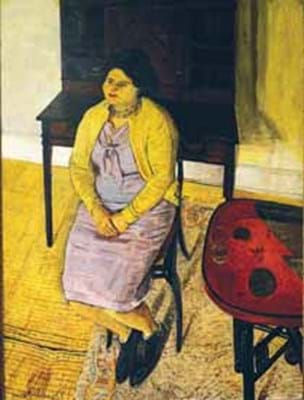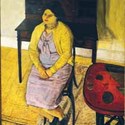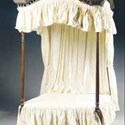Cobbled together from three different pieces of 19th century furniture, the 3ft 7 3/4in by 23 1/2in by 6ft 8in (1.11m x 60cm x 2.03m) secretaire cabinet was estimated to bring £800-1200 in their 68-lot furniture sale.
While it may have had little commercial value as a piece of furniture, its appeal lay in its provenance. It had been inherited by the private vendor from the wife of the 20th century British artist Carel Weight (1908-1997).
A professor of art at the Royal College (1957-1973), Weight's fellow staff included Francis Bacon and his students numbered David Hockney, Kitaj and Patrick Proctor.
The cabinet was made for him as a practical piece of furniture. The folio cabinet at the top was ideal for storing sketches and when the secret compartment in the frieze drawer was opened it was found stuffed with personal documents also offered for sale. They included photographs of Carel Weight collecting his CBE and pictures of him at work.
Moreover, the cabinet had also appeared in one of his paintings, Yellow Cardigan, pictured top right, as a foil for a lady sitting beside it. Its provenance made it a must for one British-based artist who paid £800 for ownership. Overall the sale totalled £36,605.
Sotheby's Olympia (20/12% buyer's premium) furniture and interior decorator outing on January 11 failed to attract the same levels of enthusiasm seen at CSK a couple of weeks later. Only 38 per cent of the 248 lots sold by volume with the sale totalling £196,700.
Sotheby's Olympia specialist Edward Rising thought quality was the issue. "We are not good at selling low value items. We are looking to consign decorative pieces but works that are of a higher calibre," he said. He plans to up the quality of consignments and raise the minimum lot value to £1000 from £750 (for consignments accepted from January) and is confident this will help boost take-up levels in future sales.
However, there were some similarities between the two sales and, as at CSK, there was strong competition for the best Italian furniture with a mid 18th century Italian walnut bureau the star turn at £17,000 (estimate £7000-10,000).
Also of note was this George III mahogany four-poster bed dating to c.1780 with an attractive pierced cornice. Unlike most four-posters from this period it was - apart from the upholstery and extended poles under the pelmet - in original condition.
Although it had attractions as a decorator's lot, it also appealed to the furniture trade who bought it at £7500.
Casualties call for quality and provenance
With standard prices of antique furniture failing to keep pace with the property market (reported on the front page of last week’s Antiques Trade Gazette), even the most optimistic market observer could be forgiven for doubting the commercial potential of a mahogany hybrid offered at Bonhams Knightsbridge (19.5/10% buyer’s premium) on January 17.








